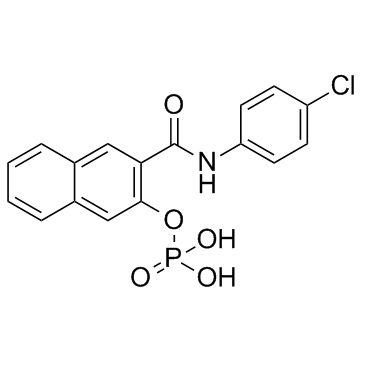KG-501

KG-501 structure
|
Common Name | KG-501 | ||
|---|---|---|---|---|
| CAS Number | 18228-17-6 | Molecular Weight | 377.71600 | |
| Density | 1.567g/cm3 | Boiling Point | N/A | |
| Molecular Formula | C17H13ClNO5P | Melting Point | N/A | |
| MSDS | Chinese USA | Flash Point | N/A | |
Use of KG-501KG-501 is a CREB inhibitor, with an IC50 of 6.89 μM. |
| Name | Naphthol AS-E phosphate |
|---|---|
| Synonym | More Synonyms |
| Description | KG-501 is a CREB inhibitor, with an IC50 of 6.89 μM. |
|---|---|
| Related Catalog | |
| Target |
IC50: 6.89 μM (CREB)[1]. |
| In Vitro | KG-501, which directly targets the KIX domain of CBP, results in a disrupted CREB-CBP complex, inhibits CREB-target gene induction, and inhibits IL-1β-mediated angiogenic activity in NSCLC[1]. KG-501 disrupts phospho (Ser-133) CREB binding to KIX with a Ki of ~90 μM, using concentrations of CREB that are within the linear range of the binding assay. Treatment of HEK293T cells with KG-501 also blocks induction of endogenous CREB target genes (NR4A2, αCG, c-fos, and RGS2) by forskolin, indicating that KG-501 likely exerts a general effect on CREB activity[2]. KG-501 can also inhibit NF-κB transcription activity because NF-κB also uses CBP as a cofactor to regulate gene expression. The migration of HUVECs induced by CM from A549 cells treated with IL-1β plus 10 μM of KG-501 is significantly lower than that induced by CM from A549 cells treated with IL-1β alone. At 10 μM, KG-501 suppresses the expression of all of the IL-1β–induced CXC chemokine genes except CXCL8. For the protein level, KG-501 significantly suppresses IL-1β–induced CXCL5 protein secretion. Similar effects of KG-501 are also observed in the H1734 cell line[3]. |
| References |
| Density | 1.567g/cm3 |
|---|---|
| Molecular Formula | C17H13ClNO5P |
| Molecular Weight | 377.71600 |
| Exact Mass | 377.02200 |
| PSA | 105.67000 |
| LogP | 4.29000 |
| Index of Refraction | 1.723 |
| Storage condition | -20℃ |
| Personal Protective Equipment | Eyeshields;Gloves;type N95 (US);type P1 (EN143) respirator filter |
|---|---|
| RIDADR | NONH for all modes of transport |
| WGK Germany | 3 |
|
Fungal recognition enhances mannose receptor shedding through dectin-1 engagement.
J. Biol. Chem. 286(10) , 7822-9, (2011) The mannose receptor (MR) is an endocytic type I membrane molecule with a broad ligand specificity that is involved in both hemostasis and pathogen recognition. Membrane-anchored MR is cleaved by a me... |
|
|
Development of a pluripotent stem cell derived neuronal model to identify chemically induced pathway perturbations in relation to neurotoxicity: effects of CREB pathway inhibition.
Toxicol. Appl. Pharmacol. 280(2) , 378-88, (2014) According to the advocated paradigm shift in toxicology, acquisition of knowledge on the mechanisms underlying the toxicity of chemicals, such as perturbations of biological pathways, is of primary in... |
|
|
Transcription factor cyclic adenosine monophosphate responsive element binding protein negatively regulates tumor necrosis factor alpha-induced protein 1 expression.
Mol. Med. Report. 12 , 7763-9, (2015) Tumor necrosis factor alpha (TNFα)-induced protein 1 (TNFAIP1) was originally identified as a protein involved in DNA replication, DNA damage repair, apoptosis and the progression of certain diseases,... |
| naphthol as-e phosphate |
| KG-501 |